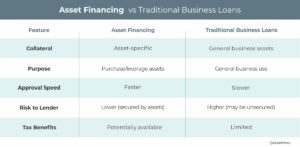
Asset Financing: A Practical Solution for Business Growth
Content
- What Is Asset Financing?
- Key Features of Asset Financing:
- Types of Asset Financing
- How Does Asset Financing Work?
- Who Can Benefit from Asset Financing?
- Benefits of Asset Financing
- Challenges of Asset Financing
- Industries That Rely on Asset Financing
- Real-World Example: Asset Financing in Action
- How to Choose the Right Asset Financing Option
- Conclusion
- Key Takeaways
Asset financing offers a practical solution for businesses looking to grow, modernise, or manage cash flow effectively. By leveraging existing or new assets to secure funding, companies can access the capital they need to invest in their operations without straining their cash reserves.
In this blog, we will explore asset financing, how it works, its benefits, and why it is a go-to choice for businesses across industries.
What Is Asset Financing?
Asset financing is a method of raising funds by using a business’s existing or newly purchased assets as collateral. These assets could include machinery, vehicles, equipment, or even accounts receivable. The financing structure allows businesses to either purchase new assets or unlock the value of existing ones to meet their financial needs.
Key Features of Asset Financing:
- Collateral-Based: Secured against physical or financial assets.
- Flexible Usage: Funds can be used for purchasing new assets or other operational needs.
- Accessible for Various Needs: Ideal for capital-intensive industries and businesses with tangible assets.
Types of Asset Financing
- Equipment Financing
- Loans or leases specifically for purchasing machinery, tools, or technology.
- Asset Refinance
- Unlocking the value of owned assets to access working capital.
- Invoice Financing
- Using accounts receivable as collateral to obtain immediate cash.
- Auto Financing (Floor Planning)
- Tailored solutions for purchasing or leasing commercial vehicles.
- Hire Purchase
- Gradual ownership of an asset by making fixed payments over time.
- Operating Leases
- Leasing an asset for a specific period without transferring ownership.
How Does Asset Financing Work?
- Asset Identification: The business identifies the asset it wants to purchase or refinance.
- Application: Financial and asset details are submitted to the lender.
- Valuation and Approval: The lender assesses the asset’s value and the borrower’s financial health.
- Loan Disbursement or Lease Agreement: Funds are disbursed to purchase the asset, or a lease agreement is finalised.
- Repayment: The borrower repays the loan or lease over a fixed period, often aligned with the asset’s useful life.
Who Can Benefit from Asset Financing?
Asset financing is particularly beneficial for:
- Small and Medium-Sized Enterprises (SMEs) needing affordable ways to acquire assets.
- Startups with limited cash reserves but tangible growth plans.
- Capital-intensive industries such as manufacturing, construction, and logistics.
- Businesses with tangible assets looking to unlock their value for immediate capital needs.
Benefits of Asset Financing
- Preserves Cash Flow
- Avoid large upfront payments by spreading costs over time.
- Easier Qualification
- Secured loans reduce lender risk, making it easier to qualify compared to unsecured loans.
- Flexible Financing Options
- Tailored solutions for different asset types and business needs.
- Accelerates Growth
- Enables businesses to invest in critical equipment, technology, or infrastructure without delays.
- Tax Advantages
- In many cases, payments on asset financing may be tax-deductible. Consult with a tax advisor for specifics.
- Builds Creditworthiness
- Timely repayment can improve a business’s credit profile, making future financing easier to secure.
Challenges of Asset Financing
- Risk of Asset Repossession
- Failure to meet repayment terms could result in the lender seizing the asset.
- Depreciation Concerns
- The asset may lose value over time, potentially making refinancing less attractive.
- Higher Costs Over Time
- Interest payments and fees can make financing more expensive than outright purchase.
- Collateral Limitations
- Some businesses may lack sufficient or high-value assets to secure funding.
Industries That Rely on Asset Financing
- Manufacturing
- Funding for heavy machinery and production lines.
- Construction
- Financing for tools, vehicles, and equipment like cranes or excavators.
- Healthcare
- Equipment financing for diagnostic tools, surgical instruments, or medical technology.
- Retail and E-Commerce
- Funding for point-of-sale systems, inventory storage, or delivery vehicles.
- Transportation and Logistics
- Leasing or purchasing fleets for goods delivery and supply chain operations.
Real-World Example: Asset Financing in Action
Scenario: A mid-sized construction company wins a large contract but lacks the funds to purchase the necessary heavy equipment.
Solution: The company secures equipment financing to buy a crane and bulldozer. The loan term is five years, aligned with the expected lifespan of the equipment.
Outcome: The company completes the contract successfully, generating revenue that covers loan repayments while leaving a significant profit margin.
How to Choose the Right Asset Financing Option
- Understand Your Needs
- Define whether you need financing for purchasing new assets or unlocking capital from existing ones.
- Compare Lenders
- Research lenders offering competitive rates, transparent terms, and tailored solutions.
- Evaluate Costs
- Consider interest rates, fees, and potential tax benefits to determine the overall cost.
- Check Asset Value
- Ensure the asset’s value aligns with your financing goals and long-term plans.
- Seek Expert Advice
- Consult with financial advisors or industry experts to select the most suitable financing structure.
Conclusion
Asset financing is a powerful tool for businesses looking to acquire, upgrade, or leverage their assets to drive growth. By offering flexible repayment terms, preserving cash flow, and enabling access to high-value assets, it supports businesses in staying competitive and agile in today’s fast-paced market.
Whether you are a startup needing new equipment or an established company looking to unlock the value of your assets, asset financing provides the financial flexibility you need to thrive. Evaluate your needs, research options, and take the first step towards smarter financial management today.
Contact us to help evaluate your company’s cash flow needs and choose the best business financing solution to ensure reliable access to working capital and fuel growth.
Key Takeaways
- By leveraging existing or new assets to secure funding, companies can access the capital they need to invest in their operations without straining their cash reserves.
- Asset financing is a method of raising funds by using a business’s existing or newly purchased assets as collateral. These assets could include machinery, vehicles, equipment, or even accounts receivable.
- By offering flexible repayment terms, preserving cash flow, and enabling access to high-value assets, this flexible financing option supports businesses in staying competitive and agile.



